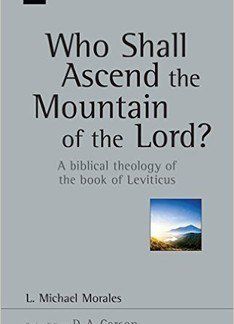This is an exceptional piece of biblical theology. It presents a fascinating study of Leviticus and sets this central book of the Pentateuch within the context of the whole biblical revelation.
The author demonstrates how the goal of God’s final redemption of his people in the new creation is life with God in his house. This fulfils the original intention of creation. The concern of Leviticus is to model the possibility of humanity living with the divine presence in the house of God.
Morales, using the ‘mountain’ imagery of the Bible, argues that ascending the hill or mountain of the Lord (Psalm 15) is associated with regaining entrance into the lost Garden of Eden to dwell with God.
The Old Testament types point to Jesus as the one who has ‘ascended the mountain’. This he did on behalf of his people, allowing the Israel of God to dwell there and ‘bask in the Sabbath-day light of God’s countenance’ (p.306).
The prologue to the book introduces the lampstand and table of the Presence within the tabernacle’s holy place. This is shown to symbolise ideal Israel living in the light of the Sabbath-day blessing of the divine presence in God’s house. Eight chapters follow, which show how this ideal picture — which became the longing of the psalmist — is finally realised.
An initial chapter indicates where Leviticus lies within the theological structure of the Pentateuch. Morales then shows how Genesis takes us from Edenic life and fullness to death in Egypt, revealing the growing alienation as people move away from the divine presence.
The patriarchal narratives give foretastes of God’s dwelling with his people. In Exodus, the tabernacle and its furnishings, resembling the imagery of Eden, is set up in the wilderness as a ‘cultic mountain of God’ (p.107). Exodus ends with the glory of the divine presence dwelling among his people. And yet, there is a problem: Moses cannot enter because of the glory cloud. It is Leviticus that provides the answer to the vital question as to who can ascend God’s mountain.
Three chapters cover the ‘dramatic movement’ of Leviticus. First, ‘Approaching the house of God’ (Leviticus 1-10) deals with worship through the sacrificial system. ‘God’s presence is never neutral’ shows how it leads either to blessing or judgment. ‘Cleansing the house of God’ (Leviticus 11-16) arises out of the Nadab and Abihu incident.
The centre of Leviticus is the Day of Atonement, and the author’s treatment of the rituals is particularly helpful. Finally, ‘Meeting with God at the house of God’ (Leviticus 17-27) shows how holiness is essential for living with God.
Chapter 7 considers how the approach to God through the sacrificial system, purity laws and programme of meetings is important to the rest of the Old Testament. There is a brief look at Numbers and Deuteronomy, before showing how the prophets and psalmists take up the theme.
The final chapter, ‘Entering the heavenly house of God: from the earthly to the heavenly Mount Zion’, brings the book to a satisfying conclusion. It explains how the Son dwelt among us in his humanity, in order to ascend via the cross and resurrection to the heavenly tabernacle, so that Christ’s Spirit might descend ‘in order to unite us to him in that heavenly reality’.
Preachers will find this work a rich source of sermon material and all who are interested in the Bible will be amazed at its unity.
Philip H. Eveson
Wrexham






